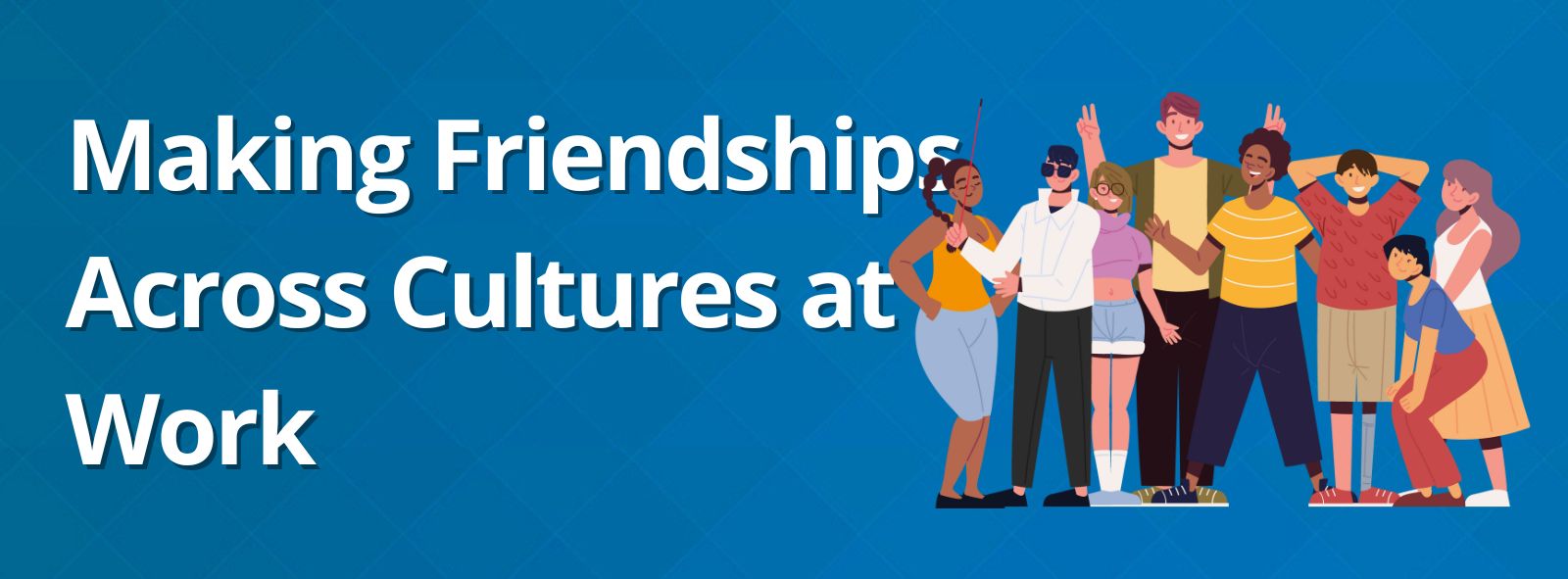Why we need work friends
It is important to have friendships at work.
According to Vantage Circle, workplace loneliness affects business, relationships and well-being[1]. In 2023, the WHO and US Surgeon General declared a global loneliness epidemic, and compared the negative effects of loneliness on mental health to the equivalent of smoking 15 cigarettes a day[2].
It stands to reason that employers who help promote workplace friendships are likely to see more harmony, productivity and wellbeing in the workplace. Additionally, if we wish to see collaborative and equitable workplaces, we need to focus not only on rethinking the significance of workplace friendships generally, but to actively promote friendships across cultural groups. Newcomers and minority groups who have friends at work, can contribute more fully to the tasks at hand, while dominant culture employees experience the delight of seeing the world through multiple lenses.
At first glance, it appears that similar culture workplace groups are happier and get work done faster than more diverse groups, but there is a significant downside.

Up and downside to culture-similar groups
Culture-similar groups tend to miss the same issues, perpetuate the same stereotypes, and cover up group mistakes. Even more importantly, homogenous work groups miss out on the joy, experience and talents of those who they perceive as different, and are less likely as a group to innovate and problem solve effectively[1].
The complexity is that similar groups of employees tend to self-segregate at work as they do in life. And there are certainly benefits to self-segregation. Feeling safe, building resilience and cultural identity pride through shared cultural norms are just a few[2].
Research on culture and workplace behaviours shows that people tend to self-segregate according to groups with whom they share characteristics such as ethnicity, language, political affiliation and religion[3]. Employees will also self-segregate according to role, status and interests. Minority employees self-segregate to feel comfortable and to take pause from the effort required to negotiate difference all day in an unfamiliar environment.
Self-segregation, hierarchy and economic advantage
Interestingly, depending on in-group and out-group attitudes, employees will either help others from similar groups or withhold information that they perceive as possibly damaging their own status and job role. For example, people from the same culture who have established themselves in a profession, may provide guidance to newcomers to get started in the workplace. Or they may mislead their compatriots and intentionally keep helpful career information away from them. This attitude of scarcity can be seen in both dominant and minority cultures. For example senior workers or managers might impose unnecessary hardship on junior workers, to give themselves a sense of security when they feel threatened.
According to African Studies UK contributor, Janani Chitra Rajendran[1], social advancement behaviour is influenced by the number of similar minority members in the organization. If the person is one, or one of few minority individuals in that organization, the higher status person is more likely to try to protect their individual “token minority” status by keeping others out.
Fear of job loss is significant for all employees. If employees know that sharing information will not be used to demote, discredit or dismiss them, they are more likely to give a helping hand to a compatriot seeking work.
From an economic advancement perspective, when similar groups sharing higher status and wealth self-segregate, it doesn’t result in equitable attitudes or fair workplace promotions. In this scenario, outside groups typically stay on the lower side of the pay scale. This has been most researched in terms of white groups keeping people of color out of positions of power[2]. However when minority groups reach a certain economic advantage in a company, the tendency to choose less qualified candidates from their own ethnic group and to overlook qualified candidates from other cultures happens in the same way. When people in any dominant group share power, money and status, they do not necessarily use it for the benefit of building pathways to success for others.
This is important to remember because it is difficult to see polarization and stereotype if everyone we know, or consider competent, looks and thinks like we do. Which is another reason why is it so important to develop work friendships across cultures.

Be intentional about promoting cross-cultural friendships
If people are going to self-segregate anyway it is less important to promote work friendship in similar groups and more important to provide opportunities to mix across groups. When new employees make a few friends across cultures within the first few months of their employment, they feel that they belong to the organization and are a part of the in-group. If employers do not consciously mix employees on projects, groups, cross-training and social events, stereotyping between groups becomes more problematic[1].
I saw this first hand during two years of tri weekly visits to my father’s extended care home before he passed away. There was a clear hierarchy between nurses and care aides from dominant minority culture groups and individuals from less numerous cultural groups. The sense of being on the “in-group” or “out-group” affected both staff morale and patient care. I observed that the isolated minority nursing staff seemed less likely to communicate with the dominant minority group, more likely to be teased and less connected to the residents. Visitors tended to consult the dominant minority nursing staff members about their family member progress more than the other minorities, further deepening the divisions between nursing staff groups.
So what can you do to promote friendships across cultures?
In the article “Building Cross-Cultural Relationships in a Global Workplace”, Andy Molinksy and Melissa Hahn[2] write that from surveying 100+ multicultural workplaces, friendships across cultures tend to build bridges across the culturally varying “codes” of “place, power, purpose, privacy, presence, and pacing”. For example, the accepted degree of public friendliness and smiling between people who do not know each other, is specific to culture but shows evidence of change over time as a larger workplace group norms emerge that can be characterized as more or less friendly.
Some useful tips
In spite of the complexity of social behaviours and cultural code switching, workplaces find that cross cultural friendships develop through:
- consistency of work expectations and
- consistency of intentional social interaction
Here are a few of the most commonly reported tips for building workplace cross-cultural friendships for each category:
- For consistent work expectations and norms:
- Communicate clear work expectations and work norms in advance of when they will be needed
- Assign buddies who meet regularly with new hires over the first three months
- Regularly schedule one to one meetings between new hires and their supervisors/managers
- Build group collaborative projects with group communication protocols and rules of engagement clearly identified
- Choose meeting chairs on a rotational basis
- During a meeting, have employees contribute one at a time while listening carefully to each other prior to opening up a group discussion
- Leadership models interest in others, courtesy, and civility
- For consistent informal cultural mixing:
- Regularly hold company party, BBQ or pot luck lunch events where employees are seated with diverse groups, and various employees are responsible for organizing events for variety
- Foster cultural exchanges with question prompts (ie. What languages do you speak/what countries have you traveled to/where would you like to visit on a holiday)
- Introduce newcomers to Canadian activities like hockey games and winter sports
- Consider using a team building game or activity at the beginning of each staff meeting (ie. What does your name mean or who gave you your name?)
- Sponsor service projects and group volunteering
- Encourage lunch time walks – ie. “take a 10 minute walk with a colleague” to encourage heath, conversation and social connection
- Encourage mentorship of new employees and cross-mentoring across the organization to share knowledge and experience
The Bridges Organization in the UK created an interesting video with people from different cultures offering tips for creating cross cultural friendships. Their 7 tips resonated with me! It can be useful to check in on your own cross-cultural friendship practices by choosing one you are already doing and reflecting on one you could start.
The tips are:
- Tip 1: Finding something in common
- Tip 2: Build shared experiences
- Tip 3: Give and receive hospitality
- Tip 4: Share stories
- Tip 5: Sacrifice screentime to make space for friendship
- Tip 6: Be kind
- Tip 7: Be curious not judgemental
Conclusion
Generally, having workplace friendships helps reduce feelings of workplace loneliness. Human beings tend to look for similar humans to create friendships in and outside of work, but they are also attracted to those who are interesting and different.
There are many benefits to having friends with similar cultural norms and behaviours but there are significant downsides if people do not mix across cultures at work, the most obvious being the perpetration of stereotypes and prejudice between groups who do not know each other.
It is important to remember that job security concerns cause people from all cultures to want to protect their economic advantages. To promote sharing of information, employees need to be assured that they will not suffer economically from helping another colleague advance their career. Clear workplace expectations and norms need to be applied to everyone, and modeled by the leadership.
As employers become more intentional about creating an environment of clear expectations and workplace norms, the workplace feels fair and equitable.
When workers have both same-culture friendships and cross-cultural friendships, problems of loneliness and isolation diminish and feelings of belonging and inclusion increase. Common experiences are built. Hospitality and story sharing abound. Kindness and curiosity are evident.
Employees are happier and show better productivity and collaboration in a climate of friendship. The organization benefits from increased innovation and problem-solving, reduced stress and overall wellbeing.
We can all actively promote workplace friendships. Using any of the tips in this article ca be a great way to start!
[1] Vantage Circle. (July 18, 2024). Workplace Loneliness- The Silent Killer Of Your Organization. https://www.vantagecircle.com/en/blog/workplace-loneliness/. Correct on September 27, 2024.
[2] Johnson, Sarah. (November 16, 2023). WHO declares loneliness a ‘global public health concern. https://www.theguardian.com/global-development/2023/nov/16/who-declares-loneliness-a-global-public-health-concern. Correct on September 27, 2024.
[3] Carucci, Ron. (January 20, 2024) One more time: Why diverse teams outperform homogenous teams. Forbes. https://www.forbes.com/sites/roncarucci/2024/01/24/one-more-time-why-diversity-leads-to-better-team-performance/. Correct on September 27, 2024.
[4] Montero R, Vargas M, Vásquez D. Segregation and Life Satisfaction. Front Psychol. 2021 Feb 5;11:604194. doi: 10.3389/fpsyg.2020.604194. PMID: 33613361; PMCID: PMC7894574.
[5] Bursell,Moa; Jansson,Fredrik. (2018). Diversity preferences among employees and ethnoracial workplace segregation. Social Science Research, 74: 62-76. https://www.sciencedirect.com/science/article/abs/pii/S0049089X17301436
[6] Rajendran, Janani Chitra. (July 19, 2023) The Token Minority Syndrome: A story of Self-Segregation at the British Workplace. https://www.africanstudies.co.uk/2023/07/19/the-token-minority-syndrome-a-story-of-self-segregation-at-the-british-workplace/
[7] Ray, Victor (November 19, 1919). Why so many organizations stay white. Harvard Business Review, Big Idea Series.
[8] Taras, Vas. (December 9, 2008). TRIEC. Integrating immigrants into the workforce takes time. https://triec.ca/integrating-immigrants-in/ Correct on September 28, 2024.
[9] Molinsky, Andy; Hahn, Melissa. (February 29, 2024). Building Cross-Cultural Relationships in a Global Workplace. Harvard Business Review, Diversity and Inclusion. https://hbr.org/2024/02/building-cross-cultural-relationships-in-a-global-workplace
About the Author
Marie Gervais, PhD, CEO, Shift Management Inc. specializes in helping employers train their middle and senior managers to lead, get their workplace learning online and interactive, and coach for emotionally regulated performance. She has a background in integrating and managing the diverse workforce and in creating culturally responsive curriculum courses and programs for industry. Marie’s book, “The Spirit of Work: Timeless Wisdom, Current Realities” to understand the deeper processes behind workplace issues and find inroads into creating healthy and vibrant organizations is available on Amazon and other online book stores. Her podcast, “Culture and Leadership Connections” features interview and leadership tips through an intercultural lens, that help employers and employees alike be better people at work.








